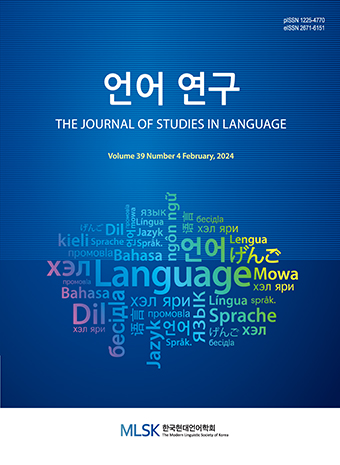Research Article
Abstract
References
Information
Many diagnostics have been proposed to examine subjecthood in Korean, some of which were investigated in terms of their validity as subject diagnostics through a series of experimental studies. This paper takes the experimental data from three experimental studies (Kim et al., 2015; Lee et al., 2015a; Kim et al., 2017) that were previously conducted, and examines the validity of six diagnostic tests using cross-validation and a machine learning method. The experimental data were evenly divided into ten parts (10-fold cross-validation): Nine of them were used for machine learning (training data set), and the remaining one was for the testing (test data set). The analysis was conducted ten times, and the average values were taken. A simple linear regression was conducted for machine learning. Through the analysis, the following results were observed: (i) The accuracy of the diagnostics for Single Subject Construction (SSC) was much higher than that of Multiple Subject Construction (MSC) (SSC: 81,78, MSC: 68.66), (ii) Adjunct Control was the most accurate for SSC, whereas Coordinated Deletion for MSC, (iii) HA and PL Showed low performance. The results also seem to imply that some parts cannot be explained by a simple linear model but can be analyzed with non-linear modeling of language.
- Andrews, A. 1985. The Major Functions of the Noun Phrases. In T. Shoepen (ed.), Language Typology and Syntactic Description. Cambridge, MA: Cambridge University Press. 132-223. 10.1017/CBO9780511619427.003
- Falk, Y. 2006. Subjects and Universal Grammar. Cambridge, MA: Cambridge University Press. 10.1017/CBO9780511486265
- Geisser, S. 1993. Predictive Inference. New York: Chapman and Hall.
- Gravetter, F. and L. Wallnau. 2013. Statistics for the Behavioral Sciences. Belmont, CA: Wadsworth.
- Gries, S. Th. 2013. Statistics for Linguistics with R: A Practical Introduction. Berlin: Guyter. 10.1515/9783110307474
- Heycock, C. and Y.-S. Lee. 1989. Subjects and Predication in Korean and Japanese. Language Research 25.4, 755-792.
- Hong, K.-S. 1991. Argument Selection and Case-Marking in Korean. Doctoral dissertation, Stanford University.
- Hong, K.-S. 1994. Subjecthood Tests in Korean. Language Research 30, 99-136.
- Kang, B.-M. 2002. Pemcwu Mwunpep: Hankwuke-uy Hyengthaylon, Thongsalon, Thaipnonlicek Uymilon (Categorial Grammar: The Morphology, Syntax, and Type-Logical Semantics of Korean). Seoul: Korea University Press.
- Kim, J.-H., E. Kim, and H.-S. J. Yoon. 2016. An Experimental Study of Subject Properties in Korean Multiple Subject Constructions (MSCs). In Proceedings of the 30th Pacific Asia Conference on Language, Information and Computation (PACLIC 2016), 183-190. Seoul: Kyung Hee University.
- Kim, J.-H., Y.-H. Lee, and E. Kim. 2015. Obligatory Control and Coordinated Deletion as Korean Subject Diagnostics: An Experimental Approach. Language and Information 19.1, 75-101. 10.29403/LI.19.1.5
- Kim, J.-H., Y.-H. Lee, and E. Kim. 2017. Honorific Agreement and Plural Copying as Korean Subject Diagnostics: An Experimental Approach. Modern Grammar Studies 93, 119-144. 10.14342/smog.2017.93.119
- Kohavi, R. 1995. A Study of Cross-validation and Bootstrap for Accuracy Estimation and Model Selection. Proceedings of the Fourteenth International Joint Conference on Artificial Intelligence 2.12, 1137-1143. San Mateo, CA: Morgan Kaufmann.
- Lee, I.-H. 1987. Double Subject Constructions in GPSG. Harvard Studies in Korean Linguistics II, 287-296.
- Lee, Y.-H., E. Kim, and J.-H. Kim. 2015a. Reflexive Binding and Adjunct Control as Subject Diagnostics in Korean: An Experimental Approach. Studies in Language 31.2, 427-449. 10.18627/jslg.31.2.201508.427
- Lee, Y.-H., J. H. Yu, and T.-J. Yoon. 2017. Predicting the Occurrence of the English Modals Can and May using Deep Neural Networks. Studies in Modern Grammar 96, 167-189. 10.14342/smog.2017.96.167
- Lee, Y.-H., Y. Park, and E. Kim. 2015b. A Multi-level Analysis of Subjecthood Diagnostics in Korean. Linguistic Research 32.3, 671-691. 10.17250/khisli.32.3.201512.006
- Mitchell, T. 1997. Machine Learning. New York: McGraw Hill.
- Park, K.-S. 1995. The semantics and pragmatics of case marking in Korean: A role and reference grammar account. Ph.D. Dissertation, State University of New York at Buffalo.
- Park, B.-S. 1973. On the Multiple Subject Constructions in Korean. Linguistics 100, 63-76. 10.1515/ling.1973.11.100.63
- Samuel, A. 1959. Some Studies in Machine Learning Using the Game of Checkers. IBM Journal 3.3, 210-229. 10.1147/rd.33.0210
- Schütze, C. 2001. On Korean ‘Case Stacking’: The Varied Functions of the Particles -ka and -lul. The Linguistic Review 18, 193-232. 10.1515/tlir.2001.001
- Teng, S-H. 1974. Double Nominatives in Chinese. Language 50, 455-473. 10.2307/412218
- Yoon, J. H.-S. 1986. Some Queries Concerning the Syntax of Multiple Subject Constructions in Korean. Studies in the Linguistic Sciences 16, 215-236, Department of Linguistics, University of Illinois, Urbana-Champaign.
- Yoon, J. H.-S. 2004. Non-nominative (Major) Subjects and Case-stacking in Korean. In Peri Bhaskararao and Karumuri VenkataSubbarao (eds.), Non-nominative Subjects, volume 2, 265-314. Mouton de Gruyter, Berlin. 10.1075/tsl.61.15yoo
- Yoon, J. H.-S. 2007. Raising of Major Arguments in Korean and Japanese. Natural Language and Linguistic Theory 25, 615-653. 10.1007/s11049-007-9020-2
- Yoon, J. H.-S. 2008. Subjecthood and Subject Properties in Multiple Subject Constructions. Talk presented at the East Asian Linguistics Seminar. Oxford: Oxford University.
- Yoon, J.-Y. 1989. On the Multiple -ka and -lul Constructions in Korean. Harvard Studies in Korean Linguistics III, 383-394.
- Youn, C. 1990. A Relational Analysis of Korean Multiple Nominative Constructions. Doctoral dissertation, State University of New York at Buffalo.
- Publisher :The Modern Linguistic Society of Korea
- Publisher(Ko) :한국현대언어학회
- Journal Title :The Journal of Studies in Language
- Journal Title(Ko) :언어연구
- Volume : 35
- No :3
- Pages :361-373
- DOI :https://doi.org/10.18627/jslg.35.3.201911.361




 The Journal of Studies in Language
The Journal of Studies in Language






